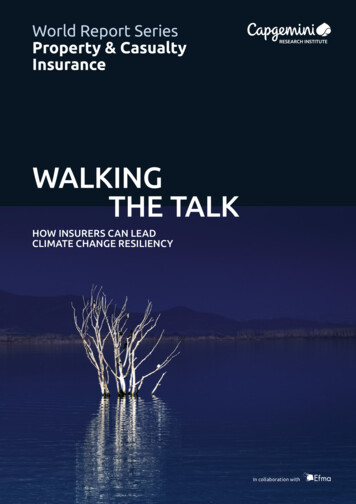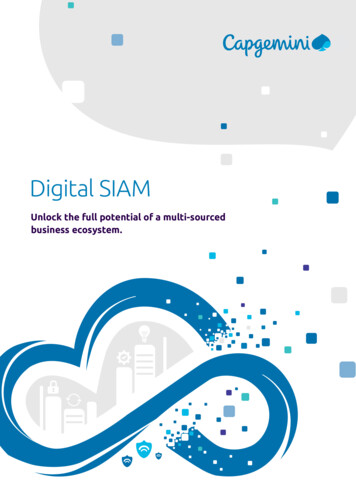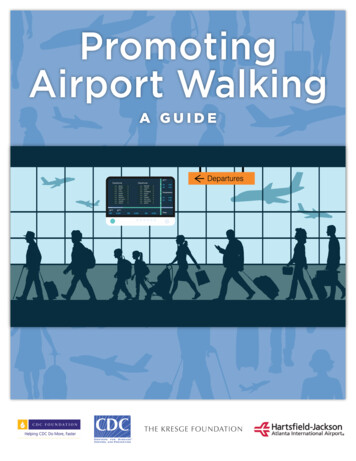
Transcription
World Report SeriesProperty & CasualtyInsuranceWorld Property and Casualty Insurance Report 20221WALKINGTHE TALKHOW INSURERS CAN LEADCLIMATE CHANGE RESILIENCYIn collaboration with
2World Property and Casualty Insurance Report 2022CONTENTSForeword3Executive steering committee4Executive summary5Climate change and its risks are on everyone’s radar6Fundamental business model changes are required9Embed climate resiliency in corporate strategy19In conclusion22Methodology23Partner with Capgemini24
World Property and Casualty Insurance Report 20223FOREWORDIt feels somewhat ironic to launch our inaugural World Property & Casualty Insurance Report Walkingthe talk: how insurers can lead climate change resiliency, during a year when eastern Antarctica recordedtemperatures 40 C (70 F) above average for more than three days.The mid-March event has essentially rewritten Antarctic climatology, said researcher Stefano DiBattista via a cautionary Twitter message. Such temperature anomalies would have been considered“impossible” and “unthinkable” before now, he added. Likewise, Jonathan Wille, a polar meteorologyresearcher at Université Grenoble Alpes in France, told The Washington Post that the mid-MarchAntarctica event might not offer a snapshot of the current state of global warming. Still, climatechange is “loading the dice” for more to come.Incidents such as this illustrate the implications of climate change and foreshadow its impact onthe insurance industry. Insured natural catastrophe losses have increased by 360% within the past30 years. Climate change has upended traditional coverage, underwriting, and investments dynamicsas today’s policyholders seek protection and peace of mind. Insurers that deliver both will positionthemselves to generate deeper customer trust and offer personalized solutions tailored to individualpolicyholder preferences and expectations.More than half of the 270 insurance executives we polled said they were implementing at least oneinitiative to help policyholders become climate-resilient. Similarly, 84% of the nearly 5,000 participantsin our 2022 Voice of the Customer survey said they are keenly aware of climate influences, are changingtheir behaviors, and have taken sustainable actions over the last 12 months.Unfortunately, our analysis suggests that only 8% of insurers are climate change frontrunners. Basedon their advanced data analysis capabilities, risk-prevention focus, and sustainability-promotingunderwriting and investments, this future-focused minority makes up our Resilience Champions.Capgemini has created a climate resiliency framework to enable insurers to build climate resiliencecapabilities within a changing risk landscape, while capitalizing on opportunities beyond risk transfer.Our report offers a roadmap to incorporate new data sources and leverage advanced technologiesto build better risk models.We realize insurers can’t do it alone, thus the need to leverage sustainability ecosystems based oncollaboration among public-private partners, communities, ClimateTechs, and climate experts. So,now, more than ever, we urge insurance firms to align across the C-suite and shift from being earlyadopters to becoming drivers of innovative and sweeping change.Today, when no region around the globe is immune from climate-change-related catastrophes,near-term corrective actions are crucial. Therefore, we invite you to call upon our international teamof subject matter experts to begin your climate resiliency journey and evolve your risk-mitigationproduct propositions.Anirban BoseJohn BerryFinancial Services Strategic Business Unit CEO& Group Executive Board Member, CapgeminiCEO, Efma
4World Property and Casualty Insurance Report 2022EXECUTIVESTEERING COMMITTEEThe Executive Steering Committee for our inaugural World Property & CasualtyInsurance Report included CEOs, CMOs, sustainability decision-makers, InsurTechleaders, industry influencers, and technology partners. They helped steer ourreport content through ideation, hypotheses refinement, validation of key findings,and sharing of best practices. Participants represent the Americas, EMEA, andAPAC to ensure a mix of global perspectives and experiences.NORTH AMERICAKimberly PalatnickNigel WalshNick AllainJoe PaluskaVP, Strategy & SustainabilityWawanesaManaging Director, InsuranceGoogleHead of MarketingZesty.aiCMOOne ConcernEUROPEHans De CuyperHanno MijerFrançois LanavèreSimon TorranceCEOAGEAS GroupGlobal HeadZurich Resilience Solutions,ZurichHead of Business DevelopmentAXA ClimateFounderEmbedded Finance &Super App StrategiesAPACDipak SahooKate LyonsRegional CIO, AsiaGeneraliGroup Head of SustainabilityQBE
World Property and Casualty Insurance Report 20225EXECUTIVE SUMMARYClimate change and its substantialrisks are on everyone’s radarClimate change is significantly affectingpeople and businesses. Not surprisingly, it isa top concern for policyholders and insurers worldwide. However, for proactive insurers,climate change can also provide an opportunityto enable purpose through actions by activelybuilding climate-resilient business models andpropositions. Over the past three decades, economic lossdriven by climate change increased by 250% Polic yholders are conscious of climatechange, and around three-quarters of them rankit among their top concerns. Insurers are in tune with customers. About40% rank climate change as a top priority, withprofitability and insurability emerging as leadingclimate-related issues While most insurers acknowledge climatechange impact, many have yet to develop aclimate resiliency strategyFundamental business modelchanges are requiredFuture-focused insurers will embed climatestrategies into their operating and businessmodels. But, that requires fundamental changessuch as revisiting data strategy, focusing on riskprevention, and moving beyond exclusions inunderwriting and investments. To achieve this,insurers need to build a resilience ecosystem bycollaborating with government, communities,and ClimateTech specialists to achieve success. Our analysis suggests that a select fewinsurers (8%) are on course to achieve climateresiliency. We call these insurance frontrunnersResilience Champions. Climate resilience requires a sophisticateddata strategy. Yet, only 35% of insurers haveadopted advanced data analysis tools such asmachine-learning-based pricing and risk models.These tools are critical to unlocking new datapotential and enabling more accurate riskassessments. Risk prevention based on data and behavioralscience is at the top of the agenda for futurefocused insurers. More than 65% of customersare interested in climate risk prevention andmitigation services, and 53% will pay for them. More than 30% of insurers restrict investmentin unsustainable companies, and more than 20%restrict coverage to unsustainable companies.Insurers that move beyond exclusions anddivestment and actively engage in risk preventionwill position themselves to support the transitionto a climate resilient economy.Insurers must embed climateresiliency into business strategyThree key actions can fuel insurers’ climateresiliency journey while boosting their relevanceand profitability and contributing more meaningfully to one of the most significant modern-daychallenges.Revisit your corporate strategy.Articulate climate resilience as a structuredpart of the corporate strategy to assure shareholders of the value-creation potential for all parties involved. Well-defined actions assigned toindividual C-level executives will ensure clearownership.Rework innovation.Encourage it to bridge the gap between longterm ambitions and short-term planning horizonsand engage with resilience ecosystem partnersto access new capabilities.Redesign your technology strategy.Deploy IoT, cloud, artificial intelligence, machine learning, and quantum computing to enable insurers’ path forward by improving riskmanagement, innovating products, transformingclaims, and elevating customer experience.
6World Property and Casualty Insurance Report 2022Climate change and its risks are oneveryone’s radarChanging weather patternsincrease economic lossesToday, no global region is safe from climatechange. For example, storms in the United Statesdrove losses of more than USD60 billion in 2021.Floods in Germany caused insured losses of morethan USD9 billion. Meanwhile, China’s insuredlosses hit nearly USD2 billion, and wildfires inAustralia caused insured losses of USD63 million.1As part of the 2015 Paris Agreement, 196countries agreed to limit global warming towell below 2 C (35.1.6 F) compared with preindustrial levels. 2The insurance industry is paying a steep priceas climate change accelerates. Natural catastropheevents have led to a 3.6 times increase in insuredlosses and a 2 times increase in uninsured lossesover the last 30 years.7Losses are rising, and insured losses forsecondary perils such as wildfires and storms have nearly doubled within the past decade. 8 Theshift is significant as secondary threats acceleratefaster than primary perils, such as earthquakesand tropical cyclones. In addition, risks aremoving from wind to water-related threats. Inthe 1980s and 1990s, Natural Catastrophes (NatCat) events were split between wind and water,each accounting for 30-35% of total events.Today, water-related perils cause around 45% ofNat Cat events.9Now, however, 2.4 C (36.3 F) warming isexpected by 2100. 3 And that means that by 2050: 410-million coastline dwellers will be at risk.4 Global economic output may shrink 11% to14% compared with GDP without climate change,according to a Swiss Re report. 5 Annual investments of USD3 to 6 trillion willbe necessary to achieve net-zero emissions. 6Don’t look up climate change is fundamentallyaltering policyholder behavior“As natural catastrophe events become morefrequent, the need for adequate insurance protectionescalates. Therefore, non-insurance is not an option.”We captured the sentiments of around 5,000customers across the globe, and climate changeemerged as policyholders’ second-highestconcern, behind COVID-19 (Figure 1).Customer s who realize the gravit y ofthe situation are acting. More than 80% ofDr. Jörg HippHead of Commercial Business Transformation, Allianz SE, GermanyFigure 1. Climate change is one of the top customer concernsPolicyholders' top three concerns84%Pandemic73%Climate %Question to customers: Please select your top concerns from the list of subjects below. Pick your top 3, and rank in 1-2-3 order.Sources: Capgemini Research Institute for Financial Services Analysis, 2022; Capgemini Voice of the Customer Survey, 2022
World Property and Casualty Insurance Report 2022individual and commercial clients have takenat least one sustainable action over the last12 months – including activities as small aswalking versus driving and as significant asinvesting in resilient structural infrastructure.Climate change has upended traditionalcoverage dynamics and today’s policyholders“The insurance industry has thegreatest opportunity and most uniqueand influential position to directlyimpact how climate change will affectcustomers over the next five years andevery generation after that. It is a gamechanging opportunity when we arealready in the second half. Our time andresponsibility to act are now.”Nigel WalshManaging Director, Insurance, Google, UKseek protection and peace of mind more thanever. By providing both, Insurers have a uniqueopportunity to generate deeper customerintimacy and loyalty, thus improving profitability.Climate change is a top concernfor insurersAs customers grapple with anxiety over potential Nat Cat events, insurers are losing sleep, too.Climate change is a top risk for insurers,with 44% of executive rating it as comparableto cyber, closely followed by financial and techthreats. Regarding climate change executivesare particularly worried about insurabilityissues, pressure on profitability and regulatoryoverheads (Figure 2).Three climate-change issues concern insurers most: Insurability Shifting risk reduces the addressable market in various regions.10 Profitability Mounting losses worsen lossratio and weaken insurers’ capital position.11 Regulation Demand for disclosure rises andregulators worldwide assess the sector’s exposureto climate risk and prescribe scenario analysis.These concerns have sparked the longest hardmarket on record, with 17 quarterly compositeinsurance rate increases.12 Unfortunately, thesechallenges are not hypothetical and have becomea stark reality in many markets.For example, California has withstood severalrecord wildfires recently, including 7,860 fires in2019, leading to a 31% hike in non-renewals bypolicyholders.13 In turn, state regulators cappedpremium prices and required insurers not tocancel any home insurance policy for 12 months.14The result? Several leading insurers pulled out ofthe California home insurance market.15The situation in California is but one exampleof why insurers need sustainable and resilientbusiness models to tackle the shifting riskenvironment. Insurers must consider ways tolimit losses while simultaneously helping to boostpolicyholder resiliency. The industry’s long-termrelevance relies on a win-win commitment andaction plan.From Germany, Dr. Olaf Frank, Head of Business Technology at Munich Re, said, “Insurabilityissues in certain high-risk areas stem from the lackFigure 2. Perceived impact of climate change for insurersInsurers concerns related to climate change74%72%54%Insurability issuesPressure on profitabilityRegulatory overheadsQuestion to insurers: How do you perceive the impact of climate change in the areas listed below? Rate on a scale of 1-7, where 1 No impact atall, and 7 Very significant impact. Responses under ratings 5,6,7 are shown in the figure.Sources: Capgemini Research Institute for Financial Services Analysis, 2022; World Property and Casualty Insurance Report 2022 Executive Interviews, 20227
8World Property and Casualty Insurance Report 2022of data to understand and calculate risks, whichultimately impedes insurers from offering coverage pricing that aligns with the global market”.In addition, CEOs will be required to championand orchestrate the evolution of operating andbusiness models enabled by C-suite leaders whowill take on shared and specific responsibilities.In Switzerland, Hanno Mijer, Zurich’s GlobalHead of Resilience Solutions, says, “It’s too simpleif insurers start to exclude highly exposed risks.The industry needs to engage with clients to understand their pathway to achieve more resilienceand how they will manage their transition.” Headds that “ progress monitoring based on datawill be key.”Insurers acknowledge climate changeimpact, but are they walking the talk?Climate risk presents a unique opportunityfor insurers to live up to their purpose throughaction. In fact, it will enable considerable growthof the Property and Casualty risk pool. Studiespredict that Property & Casualty global premiumswill rise by USD2.5 trillion over the next 20 yearsto reach USD4.3 trillion by 2040, and climatechange will drive 30% to 40% of this increase.16Insurers that capture a meaningful portion ofthis growth can create a positive flywheel momentum for all stakeholders, from employees tocustomers, while generating significant shareholders returns.Going back to 2015, we analyzed what insurershave said and done to tackle this opportunityand challenge. They consistently acknowledgedthe challenge. In recent annual reports from the35 largest market-cap insurers, we found thatmentions of sustainability terms had increasedfourfold (Figure 3). In addition, more thanthree-quarters of firms had designated a chiefsustainability officer or equivalent to beef upgovernance around sustainability issues.Are these market leaders walking the talk?Only 43% have announced a net-zero emissionstarget, and some don’t have a clear mandate ortangible goals.To truly lead the climate resiliency journey,all insurers must revisit their propositions andbalance risk prevention with risk management.Figure 3. Mentions of sustainability-related terms in insurers’ annual reports 16Keasrenci4X 4K2015Source: Capgemini Research Institute for Financial Services Analysis, 20222020
World Property and Casualty Insurance Report 20229Business model changes are needed toachieve climate resiliencyClimate change is the impetus that willtransform every company and industry. But tonavigate through the crisis, resiliency must beembedded within insurers’ DNA to enable fundamental changes to business and operatingmodels.What will the journey look like?Transforming the business and operating models will include revisiting insurers’ data strategy, focusing on risk prevention, and adopting asustainable underwriting and investment policy.Capgemini has created a climate resiliencyframework to help insurers build the requiredcapabilities within a changing risk landscapewhile capitalizing on opportunities beyond risktransfer (Figure 4).The first step in our framework requires aprofound rethinking of current risk assessmentmodels and associated data strategy. More granular data and insights can enrich risk assessment capabilities so insurers can improve customer outcomes with behavioral nudges thatencourage policyholder peace of mind and riskprevention action.Another critical aspect of our framework issustainable investment strategies and underwriting practices that drive long-term benefitsessential for insurers to encourage resilienceamong clients and stakeholders.Successful transformations in data strategy,risk prevention, investment, and underwritingstrategies can only be achieved by establishinga resilience ecosystem – by advocating public/private alliances and collaborating with innovative third parties, including ClimateTech firms andlocal communities.Resilience Champions as trailblazersTo understand carriers’ maturity in the journey towards climate resiliency, we interviewed270 insurance executives worldwide. Our conversations revealed that only 8% were on the fasttrack (Figure 5). We call these future-focusedinsurers Resilience Champions. For many otherplayers, the opportunity is to be fast followersand turning their commitments into actions.Figure 4. Capgemini’s climate-resiliency frameworkCUSTOMER OUTCOMES Drive behavioral changes Strengthen response capabilities in claimsand beyondRISK MODELS,DATA AND TECH Incorporate newdata sources Leverage advancedtechnologies and toolsINVESTMENTS AND UNDERWRITING Strengthen sustainable investment Implement sustainable underwritingSUSTAINABLE ECOSYSTEM Advocate public-private partnerships Embed new capabilities through richer ecosystemsand virtuous talent cycleSource: Capgemini Financial Services Analysis, 202282%of ResilienceChampion firmshave a chiefsustainability officeror equivalent
10World Property and Casualty Insurance Report 2022Resilience Champions unlockdata value for risk assessmentThe first step to strengthening climateresilience capabilities requires the Chief DataOfficer to explore how to access data sourcesthat provide accurate, granular, and real-timerisk information.Here Resilience Champions are ahead of thepack, with around 53% accessing more thansix new data sources, including satellite data,remote sensors, weather stations, geo-data,social media data, ESG models, and water levels(Figure 6).Chief Actuaries and Chief Risk Officersmust then work closely with Chief TechnologyOff icer s to leverage advanced tool s andtechnologies to optimize the potential of data.François Lanavère, Head of Sales and BusinessDevelopment, AXA Climate, France said “Thevalue is not the data itself. It is in what you dowith it how you explain it and transform it intoactionable insights.”While the industry has taken significant stepsin accessing new data sources, the opportunityto secure deeper insights from the data is notfully leveraged. However, Resilience Championsare leading the way here, too, with nearly 60% ofthem in advanced stages of deploying MachineLearning -based pricing models, advancedscenario analysis, and stochastic modeling.For example, Sompo International Holdings,a global specialty provider of property andcasualty insurance, partnered with Los Angelesbased Praedicat to use the analytics company’semergent risk framework, probabilistic liabilityFigure 5. Most insurers are beginning their resilience journeyInsurers' resilience oningPlease see page 23 for details of the methodology for this chart.Sources: Capgemini Research Institute for Financial Services Analysis, 2022; World Property and Casualty Insurance Report 2022 Executive Interviews, 2022
World Property and Casualty Insurance Report 2022catastrophe model, and a new litigation trackingcapabilit y to help manage Sompo’s globalcasualty portfolio.17“We have unprecedented access to data tomicro-segment customers and model certainweather and climate risks around their uniqueportfolio and assets,” says Jayme Hart, aninsurance data and analytics solutions leaderat Amazon Web Services, USA. “As a result, acarrier’s risk-model accuracy can dramaticallyimprove.”Risk prevention. The new mantrafor better customer outcomesInsurers can leverage more granular insights to develop new risk-prevention solutions, not solely to reduce losses. For example,Canada-based Kimberly Palatnick, VP Strategy& Sustainability, Wawanesa Mutual InsuranceCompany highlighted that “at Wawanesa, we’rehere to look after one another. Part of that isconsidering how, as an insurance company, we11can help build resilient communities. There istremendous value in helping people understandthe risks they face, and in encouraging preventative and sustainable behaviours.”An enormous opportunity exists for firmsto innovate new risk-prevention offerings tocreate additional revenue streams (with individual income statements) while creating a bonafide method to satisfy policyholders. Brussels-based Hans De Cuyper, the CEO of AGEASGroup, agrees that “the big opportunity aroundrisk prevention is for firms to evolve preventioninto a fee-based business adjacent to their traditional insurance business to drive resilience anddiversify revenues.”With natural disasters dominating the news,policyholders say risk prevention has become apriority. More than 65% of customers say theyare interested in climate risk prevention andmitigation services. Not only they are interested,53% also indicated they are willing to pay for riskprevention services, a significant jump from 15%in our 2019 survey.Product teams must consider how their climate-change solutionswill be accepted and adopted by consumers. It’s not only marketing’s job toengage with people about climate. Insurers must embed consumer insightsinto product designs.Nick AllainHead of Marketing, Zesty.AI, USAFigure 6. Resilience champions are leading the way in accessing new data sourcesNo. of new data sources usedAdoption of new data sources53%6 27%40%4-51-347%7%26%Resilience ChampionsIndustry averageQuestion to insurers: Select the data sources your firm uses to bolster risk assessment and monitor effectiveness. You can mark ‘Yes’to all that apply.Sources: Capgemini Research Institute for Financial Services Analysis, 2022; World Property and Casualty Insurance Report 2022 Executive Interviews, 202260%of ResilienceChampions are inadvanced stages ofdeploying MachineLearning-basedpricing models,advanced scenarioanalysis, andstochastic modeling.
12World Property and Casualty Insurance Report 2022The time has come for for ward-lookingactuaries to work closely with product andmarketing to accelerate the development ofinnovative climate resiliency risk prevention andrisk-transfer solutions.Sure, policyholders say they are interested inrisk prevention solutions. But successful adoption requires active intervention from insurersto steer individuals and organizations to action.Let’s call it a gentle behavioral nudge. 20Insurers can deploy behavioral nudges topromote win-win propositions to policyholders.As Guidewire’s Chief Customer Officer, ChristinaColby, says, “The big opportunity is encouragingpolicyholder behaviors that promote climateresiliency rather than just addressing whathappens when losses occur.”I f p o l i c y h o ld er s a g re e to i m p lem en tresiliency actions, their assets retain value,and the insurer’s financial results improve. Theconcept applies to individual and commerciallines . S o, how c an insurer s implement abehavioral nudge effectively?UK insurer leverages commercial data for riskand sustainability insightsWith offices throughout Britain ZurichUK employs approximately 5,000 insuranceprofessionals. The firm offers generaland life insurance products to retail andcommercial clients.Business challenge: Zurich UK executiveswanted to help clients understand, detect,and prevent or mitigate commercialproperty loss events while supportingsustainability efforts. However, whendozens or more structures are involved,carbon footprint reduction can be daunting,particularly as UK regulators strictly enforceefficiency mandates. In addition, today’scommercial clients want to run buildings andequipment effectively and transition fromcostly, wasteful, and harmful practices.18Strategy/implementation: When the insurerlearned that a significant amount of datacollected while managing a commercialproperty is under-utilized, it collaboratedwith GWTInsight (a UK InsurTech/PropTechfirm specializing in commercial buildingperformance). The partnership enabledZurich UK to extract property data, analyzeit and present it to policyholders in anactionable format. Through GWTInsight’sefficiency expertise and Zurich’s riskknowledge, policyholders benefitted froma 60-day structural health-check report andreal-time activity dashboard. The healthcheck suggests ways for clients to gainsustainable savings and reduce risk. The livedashboard allows users to set notificationalerts when specific data points hit setthresholds.Results: Zurich UK’s unique collaborativesolution empowers risk managers,underwriters, and claims handlers to identifycommercial property risks in real-time,allowing insights and decisions to mitigateor remove threats before they become lossevents. It addresses risk and sustainabilityby gathering consistent feedback to identifyimprovement areas. Policyholders can installthe solution independently, and Zurich UKpredicts that most clients will generatedevice ROI within two months. The insureris poised to develop additional servicebased propositions to augment its existingcoverage and risk-engineering offerings.19
World Property and Casualty Insurance Report 2022Behavioral nudges will promptclimate resiliencyLong-term, sustainable actions are ofteneasier said than done. Insurers have a uniqueopportunity to gently steer – or nudge – customer towards these actions and create win-winsolutions. If customers are more resilient theirassets retain value and insurers improve theirfinancial results. We recommend five key characteristics that we believe insurers should consider when developing these behavioral nudges,including: Social, appealing to people’s tendency tosocially conform. Insurers can begin by benchmarking prevention solution adoption amongpolicyholder peers, as utility companies dowhen they compare neighbors’ water or powerusage. Measurable quantifying the impact of theprevention solutions to appeal to customersconsidering the costs of potential losses. Actionable and relevant, offering personalized solutions tailored to individual preferencesand expectations. For example, while nearly halfof policyholders say they want discounts, othersseek benefits in kind, such as risk prevention recommendations. Timely advice delivering early warnings atthe right time through the right channels.Successful behavioral nudges require upto-date, relevant customer data and insights tocreate compelling messages delivered throughthe right channel. Firms can mine high-impactdata and insights through digital solutions andplatforms that seamlessly integrate withinpolicyholders’ day-to-day activities, possiblythrough embedded solutions in adjacent ecosystems.Insurers have the tools to embark on thiscomplex risk prevention and mitigation journey.However, success depends on strengtheningcustomer trust and venturing beyond traditional risk-transfer propositions. It also requiresacquiring and developing the right talent whocan deeply engage with policyholders throughdata-driven behavioral nudges.13
14World Property and Casualty Insurance Report 2022Resilient responsecapabilities spark superiorcustomer experienceWhile prevention initiatives aim to reducethe frequency and severity of losses, loss incidents will continue to happen. Unfortunately,our customer survey participants said claimsprocesses are sub-optimal and lengthy, payoutsand forms are complicated, and policies are notcomprehensive.“These initiatives will help us move beyond thetraditional claims model. Let’s invest in automated claimscreation and adjudication and distribute work that can’tbe straight through processed to the right people at theright time while minimizing fraud.”In tune with customer sentiments, someInsurers are now implementing new initiatives,i n c l u d i n g a e r i a l p h o t o g r a p h y, s a t e l l i t eimager y, and drones, and combining themwith fast and scalable operations to rapidlymobilize resources and support policyholdersin the most critical need.However, the most significant opportunityfor Chief Claims Officers is to rethink their claimsstrategy guided by three principles aimed at providing a faster, better, and more personalizedresponse during a loss event: Prevent future loss events. After a loss, restore affected structures at a safer location versusrebuilding on the same site. Boost insured-property resilience. Buildfloodwalls around homes that follow t
Anirban Bose Financial Services Strategic Business Unit CEO & Group Executive Board Member, Capgemini John Berry CEO, Efma FOREWORD It feels somewhat ironic to launch our inaugural World Property & Casualty Insurance Report Walking the talk: how insurers can lead climate change resiliency, during a year when eastern Antarctica recorded temperatures 40 C (70 F) above average for more than .










